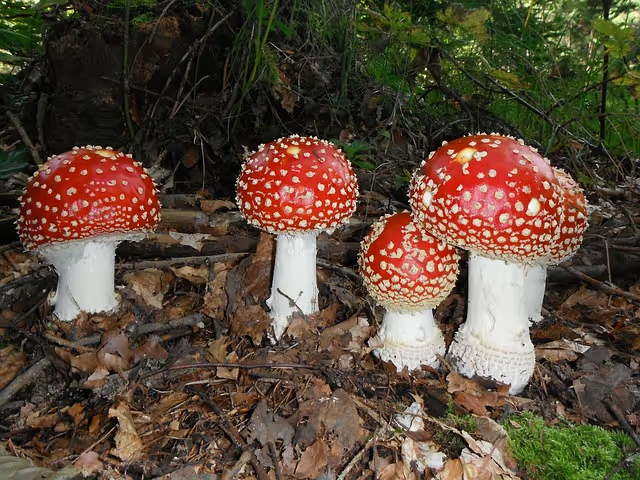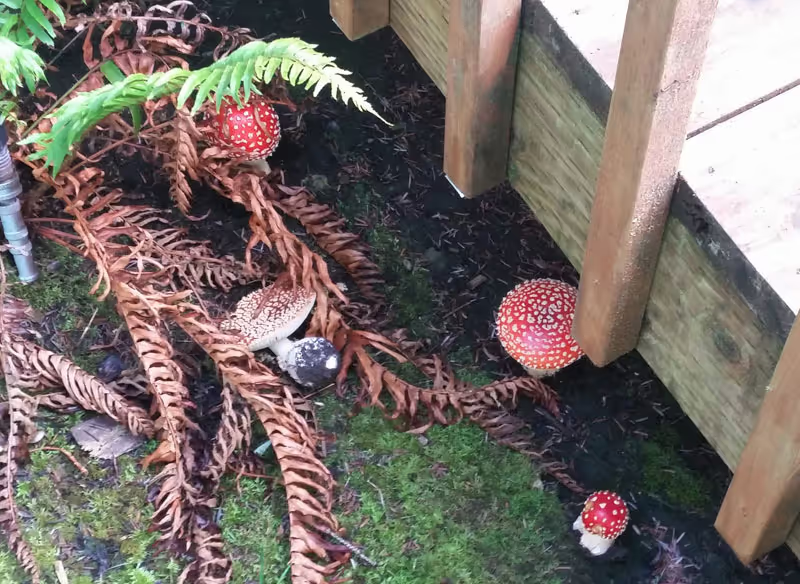Fly Agaric Mushroom


We’re well into fall now, which means it’s time for the return of the one of the most iconic toadstool species in the world, the fly agaric mushroom (Amanita muscaria). They are native to the Northern Hemisphere, though they have been introduced to the Southern Hemisphere. In Washington, they are more likely to be found west of the Cascades. In fact, they can be found in our own backyard.

Fly agarics require shade and moist, acidic soil to grow. They can often be found in woodland areas under both conifers and deciduous trees.
The mushrooms have a round red cap that flattens out as they age. In North America, the caps may also be orange or yellow in color. They can reach up to 12 inches in diameter. They typically have a smattering of white warts. Young fly agarics are entirely covered with white warts and as they mature, the warts will become more widely dispersed as the cap color shows through. The warts of mature mushrooms become fragile enough to be washed off in the rain.
The stalk is white and can reach 6-8 in length. It has a bulbous base and tapers toward the top. The gills are while and free from the stem. It also has a skirt-like ring partway up the stem. This ring helps distinguish fly agarics from similar Amanita species.

The name “fly agaric” refers to its traditional use as an insecticide, where the caps were crumbled and placed in a saucer of milk. The caps contain ibotenic acid and muscimol, both of which are water soluble and known to attract and poison flies. Other animals, such a reindeer and red squirrels, have been known to ingest fly agarics, with the former showing symptoms of intoxication afterwards.
The mushrooms can be poisonous to humans as well, though deaths are rare. Symptoms include hallucinations, drowsiness, vomiting, nausea, stomach pains, diarrhea, muscle spasms, hypotension, and agitation. Most symptoms resolve within 12-24 hours.
Fly agaric mushrooms are known for their psychoactive and hallucinogenic properties. They have been used as an intoxicating substance across cultures in the Northern Hemisphere since ancient times, particularly among several indigenous peoples of Siberia and the Sámi (Laplander) people.
In popular culture, fly agaric is often depicted alongside fairies, gnomes, and other fantastical woodland creatures. They appear in Lewis Carrol’s Alice in Wonderland and Thomas Pynchon’s Gravity’s Rainbow as a hallucinogenic. They also appear in several video games, most famously in the Mario franchise.
They are even thought to have inspired Santa Claus. There are accounts of shamans in Central Asia collecting fly agaric mushrooms in a leather sack while wearing red and white clothing. They also supposedly entered and exited their yurts through the smoke hole. Though the influence of the mushrooms on Santa is subject to debate, it is true that fly agaric were commonly used in winter solstice celebrations.
While fly agaric mushrooms can be consumed safely if properly boiled in multiple waters, symptoms can be unpredictable and they can easily be mistaken for other Amanita species (which include some of the deadliest mushrooms on Earth). Therefore they are probably best left admired.
References
Beaty Biodiversity Museum. (n.d.). Amanita muscaria - the fly agaric. Mushrooms Up! Edible and Poisonous Species of Coastal BC and the Pacific Northwest. Retrieved October 22, 2021, from https://www.zoology.ubc.ca/~biodiv/mushroom/A_muscaria.html.
North Carolina State University Extension. (n.d.). Amanita muscaria. North Carolina Extension Gardener Plant Toolbox. Retrieved October 22, 2021, from https://plants.ces.ncsu.edu/plants/amanita-muscaria/.
Schwarcz, J. (2019, December 19). The origins of Santa...maybe. McGill University Office for Science and Society. Retrieved October 23, 2021, from https://www.mcgill.ca/oss/article/history/origins-santamaybe.
Smith, D. (2020, December 23). Amanita muscaria: 'shroom like Alice did on a psychedelic growing right here in Alaska. The Anchorage Press. Retrieved October 23, 2021, from https://www.anchoragepress.com/weed/amanita-muscaria-shroom-like-alice-did-on-a-psychedelic-growing-right-here-in-alaska/article_ebb843d0-453d-11eb-922e-9f906d734490.html.
Tranfield, W. (n.d.). Amanita muscaria. Burke Herbarium Image Collection. Retrieved October 21, 2021, from http://biology.burke.washington.edu/herbarium/imagecollection/taxon.php?Taxon=Amanita+muscaria.
Wilson, M. (2019, October 22). Alaska's three types of amanita muscaria. Juneau Empire. Retrieved October 21, 2021, from https://www.juneauempire.com/news/alaskas-three-types-of-amanita-muscaria/.
© Laura Caldwell, October 2021
Touch whale bones, examine shipwreck artifacts and connect with the coast's living history.

Support our mission, get involved in educational programs, or contribute through donations and volunteering.